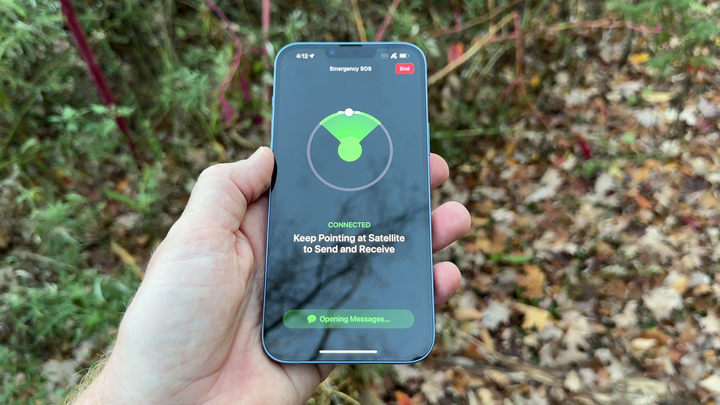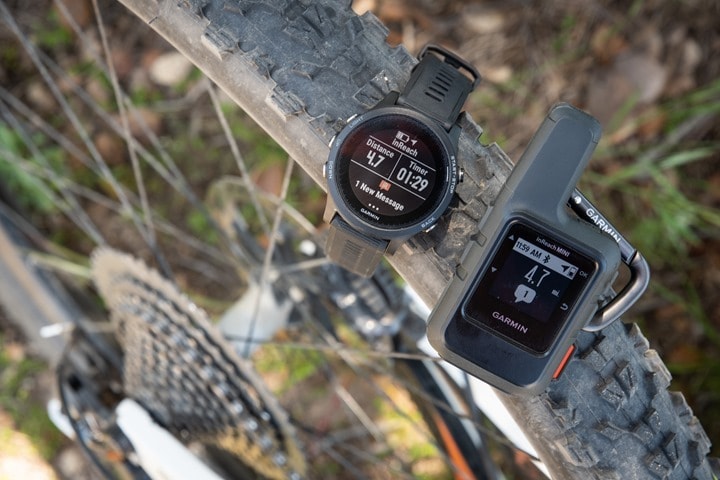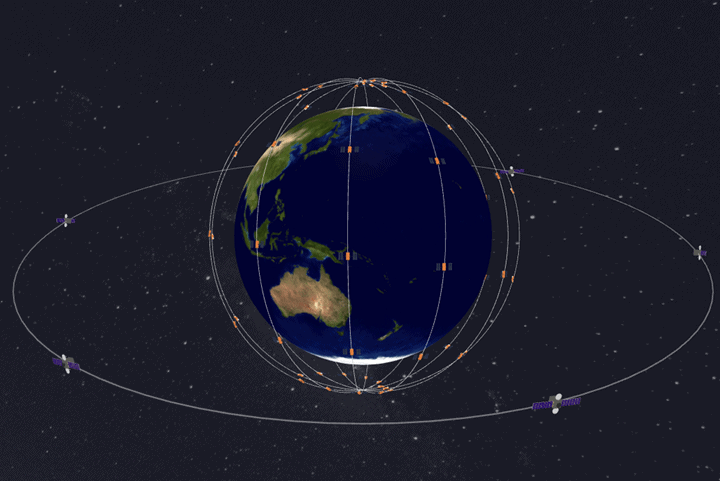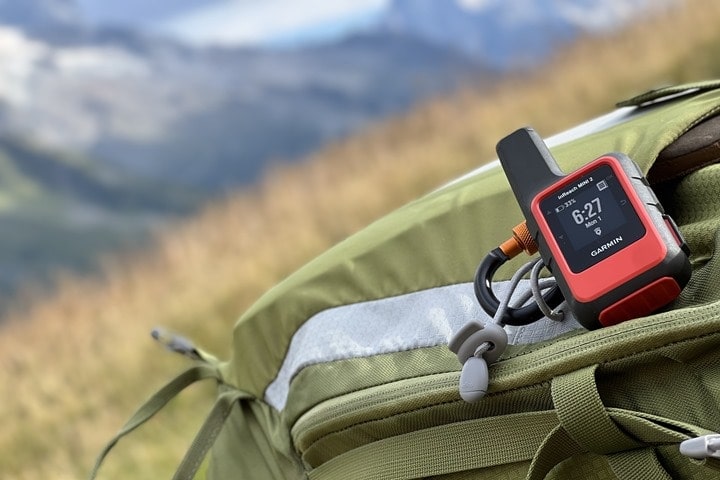Back in 2018 and 2019, the annual Consumer Electronics Show (CES) reached peak sports tech goodness. There was nearly an entire hall full of sports tech companies big and small – many with elaborate booths and even scheduled fitness-focused dance performances every 30 minutes. By CES in early January 2020, that had started to fade quite a bit, and then of course CES 2021/2022 were impacted by COVID. This year for CES 2023, it was even more muted, with virtually no sports tech-related announcements. The most notable health/fitness announcement was a toilet bowl urine analyzer. And, while certainly interesting in its own unique way – this was no 2018.
But buried at the end of a press release from Qualcomm and Iridium last week was a single quote from the head of Garmin’s Outdoor division (overseeing Fenix/Epix/Instinct/inReach/handhelds/etc), talking about a barely mentioned new partnership designed to go head-to-head with Apple’s Emergency SOS via Satellite search that was launched back in November (and December in Europe).
“Garmin welcomes the opportunity to expand our proven satellite emergency response services to millions of new smartphone users globally,” said Brad Trenkle, vice president of Garmin’s outdoor segment. “Garmin Response supports thousands of SOS incidents each year and has likely saved many lives in the process, and we are looking forward to collaborating with Qualcomm Technologies and Iridium to help people connect to emergency services no matter where life takes them.”
Now from a technical standpoint, the announcement from Qualcomm is grander in plans than what Apple has implemented to date. It’s not limited to just emergency services, nor just a handful of countries. So let’s dive into how Garmin specifically is involved, and whether or not they might leverage the chipset in the near term, all of which is pretty fascinating.
Snapdragon Satellite & Emergency Response:
To back up a bit, Qualcomm announced their Snapdragon Satellite, which is atop their Snapdragon 8 Gen2 mobile platform. This chipset is primarily used by phone and tablet makers, as well as other larger form factor devices as a do-it-all component. It does everything from WiFi to cellular, graphics handling, and CPU. It’s the core of a smartphone. However, the key new feature is Snapdragon Satellite, which would allow phones direct communication with satellites. This would ride atop Iridium’s low-earth-orbit (LEO) satellites, which are currently used by a number of companies including Garmin’s inReach devices.
Qualcomm specifically noted that this chipset will be “used by Emergency messaging on Snapdragon Satellite…planned to be available on next-generation smartphones, launched in select regions starting in the second half of 2023”. Meaning, they’ve already sign-up some manufacturers with this chipset, and those manufacturers are already likely testing these chipsets in early pre-production form. Additionally, Qualcomm noted that it’s more than just emergency features, saying:
“Qualcomm and Iridium entered into an agreement to bring satellite-based connectivity to next-generation premium Android smartphones. Garmin looks forward to collaborating with support for emergency messaging.
Snapdragon Satellite offers truly global coverage from pole to pole and can support two-way messaging for emergency use, SMS texting, and other messaging applications – for a variety of purposes such as emergencies or recreation in remote, rural and offshore locations.”
There’s a fair bit of notable stuff in that press release opener quote. First, this chipset/satellite combo will have enough bandwidth for premium communications, things like regular text messaging. You’re not streaming YouTube over this yet, but rather just simple text. Still, that’s more than Apple allows today, which is a highly compressed emergency-only text function (and also highly-compressed FindMy updates). However, like Apple, Qualcomm is announcing emergency functions first, and specifically, emergency response functions via Garmin.
Today, Garmin inReach satellite communicator (and other inReach embedded devices) communicate to Garmin’s IERCC (International Emergency Response Coordination Center), which Garmin is slowly shifting towards just calling it “Garmin Response”. Basically, when you fall off the side of a cliff in the middle of Alaska or Zimbabwe without cell coverage, it contacts via satellite the emergency response center, which coordinate with various local entities to save your bacon. Garmin recently announced their 10,000 ‘save’ via this service (and 105,000 SOS calls overall).
(If you want to see what happens when you press that SOS button in the real world, here’s a post and video I did showing it.)
In this model, Garmin’s emergency response center is roughly akin to what Apple has developed with Globalstar (a satellite provider that also now has an emergency response center), except that Garmin handles it no matter where on earth you are, whereas Apple is just a handful of countries today. Inversely, Apple only requires an iPhone 14 series device, whereas Garmin requires an inReach device (or Forerunner 945 LTE). Both require subscriptions, though Apple has waived the fee for the first two years.

However, the point of all that backstory is that today the only route into the Garmin Emergency Response system/center is via a Garmin device. But this Qualcomm partnership aims to change that in a big way. Going forward, Qualcomm customers using this chipset will essentially have a plug & play option to utilize Garmin’s Response center.
This means that later this year when whomever that phone manufacturer is that is using this chipset could have customers tap directly into the Garmin Response center, just like Apple iPhone users connect to Apple’s emergency response centers. The idea being that a company like Samsung, Oppo, Xiaomi, and others have effectively an easy-button to offering competing satellite emergency services.
While nobody is going to discuss future subscription pricing, undoubtedly with Apple offering a free 2-year trial, realistically anyone else is going to have to match that – especially for flagship phones. Qualcomm chipsets are heavily used across Android phones/tablets (albeit with Google Pixel switching to Tensor this past year). Obviously, this isn’t targeted at Apple, given Apple is spending half a billion dollars (Billion with a B, like buffalo) to launch their competing service.
Finally, it’s worth noting that T-Mobile and SpaceX announced a partnership as well, back in August. However, there is very little concrete information about the effort, and in a best-case scenario it might be beta testing by the end of 2023 (limited to the United States). The first batch of 54 Gen2 satellites finally just launched 10 days ago (out of a planned 7,500 satellites). Still, no matter how one feel’s about Elon Musk’s ventures, even his most ardent supporters would agree that while he usually eventually completes what he promises, things are rarely on time (or anywhere near it). The August announcement was made days before Apple’s fall satellite announcement, mostly as a PR/marketing preempt. Still, fast forward to 2024 or 2025, and what Space-X is outlining could be incredibly fascinating.
Satellites in Garmin Bike Computers or Watches?
This of course then immediately begs the question, will we start to see these Qualcomm chipsets in other Garmin devices instead of the larger inReach antennas? And would that mean smaller devices like a bike computer or GPS watch might soon have direct-to-satellite connectivity?
Well, it’s complicated.
To begin, I asked Garmin whether or not this chipset would sidestep the need for the larger/bulky satellite antenna found on an inReach device today. The answer there is “with tradeoffs, yes”, meaning that when you have this chipset it has a corresponding smaller antenna that’s designed for a smartphone form factor. This means there are tradeoffs in things like how reliable the transmission is, or how a user would use it.
For example, with Apple’s iPhone 14 solution, the user has to basically point the phone towards a specific location (satellite) in the sky. Qualcomm also has a relatively similar demo showing the same thing. And specifically, you stop and do this when you want to communicate via satellite. Whereas with a Garmin inReach device and its omnidirectional antenna, the communications just happen 24×7 in the background, because the antenna can always find satellites. But again, there’s the tradeoff in antenna size (you can see the antenna at the top of the orange inReach device, two photos below). Here’s the user prompts while using Apple’s satellite service:

In other words, Garmin sees this as an alternative technology solution for different platforms/use cases – but one that still ultimately lands at Garmin’s emergency response center doorstep to handle/process. For the average consumer smartphone, you can’t have a giant inReach-style antenna sticking out the top, whereas, you can have a seamless and invisible antenna that can be leveraged on-demand for emergency or other short messages.
Looking at Garmin’s current inReach product lineup, the Snapdragon Satellite chipset doesn’t really work for most of these devices. First, it’s got too high a power draw to be on 24×7 in a handheld device. Remember, Snapdragon Satellite as a feature is largely designed to be event-focused (e.g. sending a single message), whereas inReach is typically designed to be constantly communicating at intervals in the background. Second, Garmin says the solution doesn’t meet the component cost requirements for Garmin’s lower-priced inReach devices (e.g. $299 for an inReach device, as compared to a $1,000+ smartphone). However, Garmin again notes that for smartphones with larger batteries or higher price points, Qualcomm’s solution is appealing.
For cyclists and others, that immediately begs the question of whether or not Snapdragon Satellite be leveraged in something like a bike computer?
Obviously, never say never, but for now, speaking generally, the answer is no. Specifically, Garmin noted two challenges: The first is simply that the components cost is cost prohibitive (today) for a bike computer format. Meaning that like the $299 inReach device cost component challenge, the same is true for Garmin’s bike computers costing $299-$749. In the same way that solar components are still very expensive for Garmin (despite owning the technology), and why they’ve largely been reserved for higher-priced devices to date. Obviously, as with any component, they get cheaper over time, and can be counter-balanced with other cheaper build costs (see: Garmin Instinct Solar series).
The second challenge Garmin says for bike computers is that “fixed-mount” nature can be challenging from a connectivity standpoint. Again, remember that with Snapdragon Satellite, in a phone, the solution requires you point your phone at the specific satellite passing by. Certainly, you can remove the bike computer from the bike and do this, but there are some user experience components there that this wouldn’t be when just riding along, but really more of an emergency solution (hence why power draw actually wasn’t Garmin’s concern in a bike-computer format, since it’d basically have to be manual/on-demand only).
So if you were hoping to find Snapdragon Satellite in a bike computer coming to you soon, that seems pretty darn unlikely. Garmin however currently has direct integration already with their inReach devices to their Edge bike computers (and most higher-end Garmin watches). That allows you to send/receive messages on the Edge display, with a connected inReach device. Of course, while that’s a good first step, I think a lot of us would also love to see seamless hand-off between cellular and inReach Live Tracking (for example), which isn’t done today. Nor is there any emergency notification of crashes via inReach satellite devices today. All are largely software-focused areas that Garmin could implement internally.
Going forward:

Undoubtedly, more accessible low earth orbit satellite connectivity will be “5G” style topic over the next few years. We’ve finally gotten past everyone putting 5G in every marketing thing they can, but I suspect satellite connectivity will become that replacement frontier. And perhaps for good measure. While faster internet is always interesting, having more accessibility to the internet in far-flung places is arguably just as useful (if not more useful). Even if that connectivity is low-speed.
As I said when Apple launched their satellite SOS system on the iPhone 14, if we fast forward 3-5 years from now, virtually everyone that has an iPhone will have emergency response center access. We’re already seeing it save lives in just the last two months, and for people like my father-in-law who lives in very remote Canada and travels deep off the grid, this type of technology becomes instantly accessible via just an inevitable and eventual new phone purchase.
What Qualcomm is doing with Garmin for Snapdragon Satellite is apply that same long-term vision for the rest of the world on Android. And long term, if we think about the investment that Apple has made with Globalstar (hundreds of millions of dollars to support initial rollout), that sort of same cash flow will be flowing towards Garmin and Iridium (and a lesser extent Qualcomm). Long term, this could become a massive source of revenue. So when people talk about Apple SOS (or likewise) killing Garmin inReach, I suspect Garmin is just sitting back knowing that they’re still gonna end up with plenty of Android-driven response revenue either way. And that all ignores the simple reality that today inReach devices fulfill a different need than smartphone satellite connectivity.
And hey, maybe down the road they’ll figure out how to bake Snapdragon Satellite or similar satellite componentry and antennas into bike computers (or perhaps bike lights/radar, or bike-specific accessory) such that it can work in an always-on tracking config without having to hold your phone/device like a token to the satellite gods.
With that, thanks for reading!


![clip_image001[6] clip_image001[6]](https://media.dcrainmaker.com/images/2023/01/clip_image0016_thumb.jpg)
![clip_image001[8] clip_image001[8]](https://media.dcrainmaker.com/images/2023/01/clip_image0018_thumb.jpg)

0 Commentaires